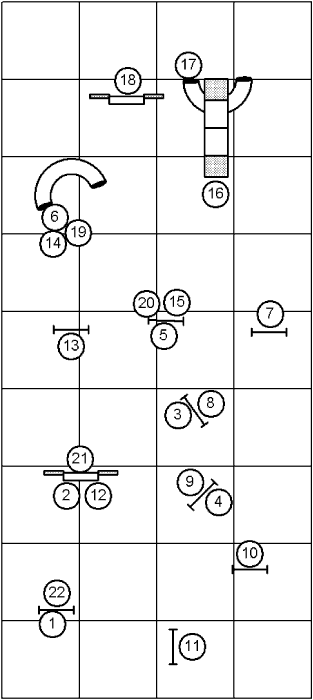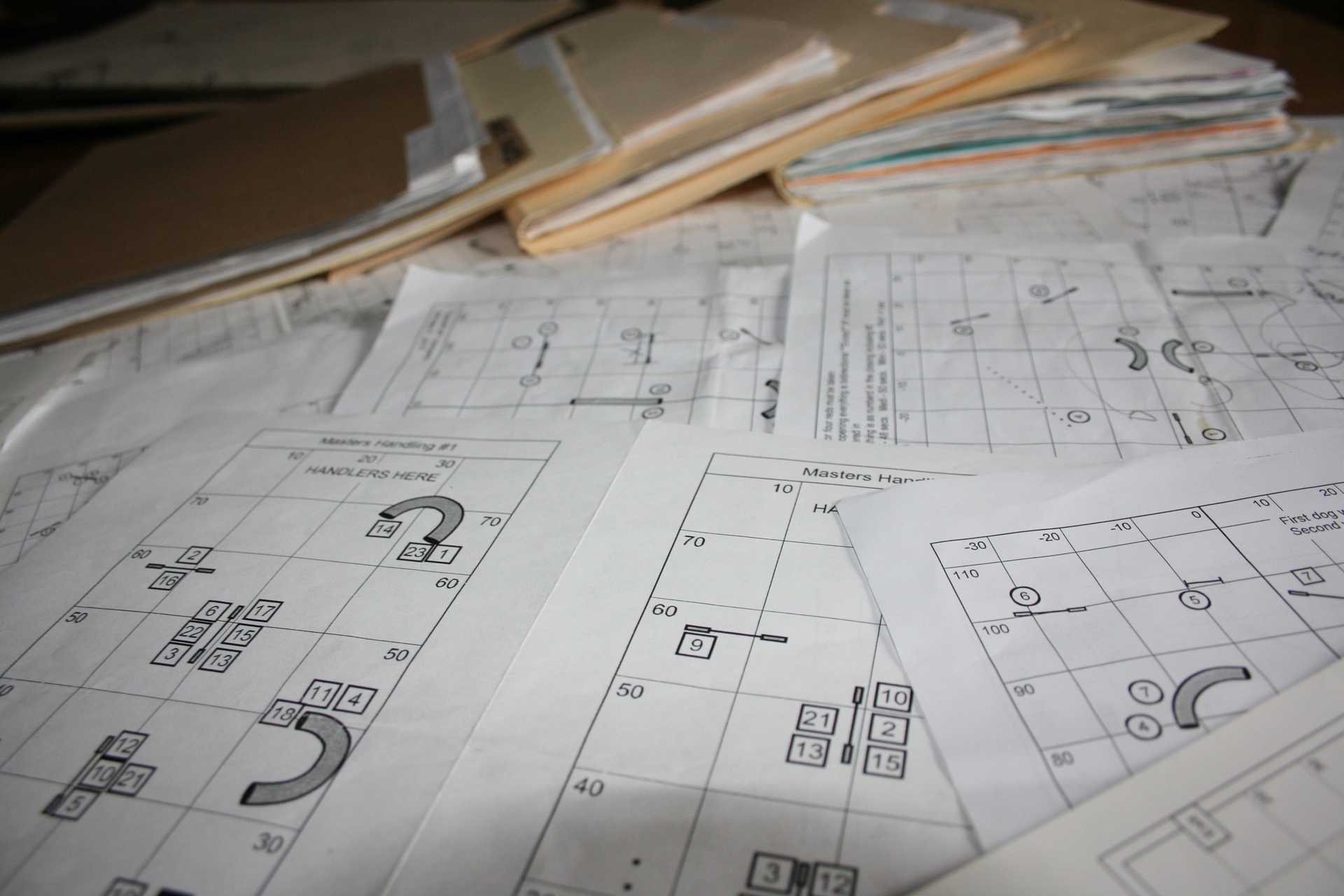Dana Pike Advanced Class Course - Mar 10, 2005
12 Mar 2005
Dana Pike designed another great course for her advanced class this past week. As usual it was another learning experience. Pay special attention to sequences 3-4-5-6, 7-8-9-10 and 17-18-19. Here's her course:
Here’s my analysis some of the challenges and different handling approaches to this course:
The opening three obstacles appeared to be a straightforward
Lead Out situation. CY pointed out that if the handler lead out and was some what past the Handler Line Using the Handler Line - Front/Rear/Blind Cross LineHandler Line - Front/Rear/Blind Cross Line between jumps 2 and 3, you could use a Post Turn Learning the Post TurnPost Turn/Shoulder Pull/Pivot Turn to get a tighter path through jumps 3 and 4.Using a Post Turn through 270 Degree Jumps Mr Peabody in UKC Bloodlines MagazineHandling 270 Degree Jump SequencesBack Side Entry to 270/Training Opportunity - Video270 Degree Jump Sequence 3 and 4 was the most common handling. But some handlers tried to
Front Cross Learning the Front Cross - VideoFront Cross jump 4 and take their dogs on their right to jump 5. Unfortunately, jump 3 was just too close for this handling and drew almost 100% off courses when this handling was attempted.Once through the 270 and over jump 5 the off course to the right side of the tunnel beckoned. Handlers who were late to change their dog’s
Lead Leg sent their dogs straight into the wrong side of the tunnel.Once again, CY pointed out a better solution was to Post Turn the dog through the 270 and step forward just enough to get the dog past jump 3. Then Rear Cross Learning the Rear CrossRear Cross to put the dog on a left Lead Leg before jump 5. This set the dog up perfectly on line to the left side tunnel entrance. I had a tough time getting my timing just right for the Rear Cross with Milo, I usually didn’t wait long enough and then pushed him past jump 5. You’d think by now I could remember Rear Crosses are all about being patient - you have to wait for your dog to be in position before changing their lead.
Coming out of the tunnel a fast handler could Front Cross on the landing side of jump 7. But it turned out Rear Crossing before jump 7 and again after jump 9 gave the dog a nice path. I might not have the diagram quite right from jump 9 to 10; it was the minimum jump spacing and long strided dogs had to land from jump 9 and immediately turn towards jump 10 without taking another stride to take the jump cleanly.
As long as the handler didn’t go too deeply towards the off course jump 1 it was a straight run through jumps 12 and 13 and back into the left side of the tunnel.
The first time through the course almost all handlers used a Front Cross at the exit of the tunnel and a Post Turn around jump 15. For a lot of dogs who came rocketing out of the tunnel this was a very wide path for the dog (they were at full speed since they’d just come over a 60 foot three jump sequence before the tunnel). Some dogs even took the off course jump 8.
After discussing the course, CY pointed out that if the handler stayed back and got the dog to change their Lead on the way to jump 15 by performing a Rear Cross, the dog’s path was much shorter and tighter to the jump. The interesting part was it was hard for some handlers (myself included) to control their momentum and not overrun the end of the tunnel. Like the dogs, we had just run 40 feet at full speed to the tunnel and it “felt right” to get to the exit and Front Cross. You really had to put on the brakes and pause briefly for the dog to come out of the tunnel in order to get in position for the Rear Cross. But the dog’s path was much, much better with this handling.
At the end of the A Frame it was a simple Post Turn (counter rotation - handler turns to their right and the dog turns to their left) to get the dog into the tunnel… and then the fun started. Most handlers wanted to Front Cross on the landing side of jump 18 to keep the dog out of the off course side of the tunnel. This required the handler to
Support the Dog's Line and get around the wing of the double and only start the Front Cross when the dog was committed to the jump. It was tough getting the timing right.It was funny a number of us were successful using the Front Cross the first time through the course, but we couldn’t do it again. On subsequent runs Milo kept coming around the wing of the jump. I finally ended up using a Post Turn over the jump and a Rear Cross into the tunnel. It was interesting that the much more challenging (and to a degree riskier) Front Cross wasn’t really necessary, the off course tunnel opening was ignored by all the dogs when the handler used a Rear Cross.
The closing wasn’t a problem for any teams and some handlers layered jump 13. Other handlers put in a Front Cross between jumps 20 and 21 to control the dog’s path through the last two obstacles.
Every week training with Dana provides another set of interesting challenges and this course is no exception.
If you enjoyed this article won't you please:  Thanks!
Thanks!
